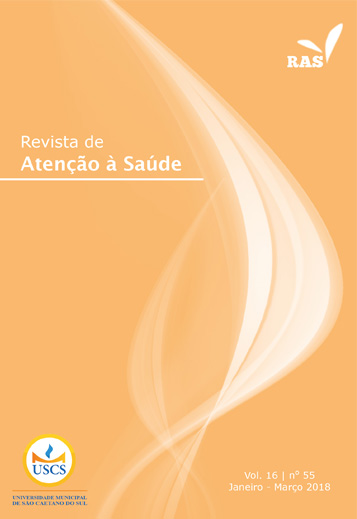PREVALENCE OF OVERWEIGHT AND ASSOCIATED DEMOGRAPHIC AND ECONOMIC FACTORS AMONG ADOLESCENTS OF MANAUS, THE LARGEST CITY OF NORTHERN BRAZIL
DOI:
https://doi.org/10.13037/ras.vol16n55.4855Keywords:
Nutritional status, adolescent health, anthropometry, epidemiologyAbstract
Introduction: Estimates of overweight prevalence among Brazilian adolescents have been made in several states, but the scarcity of data about the adolescents from Northern region is evident. Objective: To estimate the prevalence of excess weight and its association with demographic and economic factors in adolescents from Manaus, Amazonas, Brazil. Methodology: A cross-sectional study was conducted among 1,107 adolescents (627 girls), with ages ranging from 14 to 19 years, in Manaus city, in the year 2011. Overweight was classified by using body mass index and adopting the cut-off points for gender and age recommended by the International Obesity Task Force (IOTF). The independent variables were gender, age, household income and educational level of the mother. Associations were tested using Poisson regression. Results: The prevalence of overweight was 37.4% (95% CI = 34.6-39.8). The adolescents who are male (PR = 2.54; 95% CI = 2.12-3.03), the ones who are 14 to 16 years old (PR = 1.23; 95% CI = 1.06-1.44), and the children of mothers with higher level of education (PR = 1.66; 95% CI= 1.44-1.92) were more likely to have excess weight when compared to the female ones, to those aged 18 to 19 years and to children of mothers with lower schooling level, respectively. Conclusion: The overweight prevalence was high in relation to other Brazilian studies. The preventive measures for excess weight should be directed mainly to male adolescents, to the youngers and to children of mothers with higher education level.
Downloads
References
Cardoso LO, Engstrom EM, Leite IC, Castro IRR. Socioeconomic, demographic, environmental and behavioral factors associated with overweight in adolescents: a systematic literature review. Rev Bras Epidemiol. 2009;12(3):378-403.
Ariza C, Ortega-Rodríguez E, Sánchez-Martínez F, Valmayor S, Juárez O, Pasarín MI. La prevención de la obesidad infantil desde una perspectiva comunitaria. Atención Primaria. 2015;47(4):246-55.
Guedes DP, Paula IG, Guedes JERP, Stanganelli LCR. Prevalência de sobrepeso e obesidade em crianças e adolescentes estimativas relacionadas ao sexo, à idade e à classe socioeconômica: Rev Bras Educ Fís Esp. 2006;20(3):151-63.
Kneipp C, Habitzreuter F, Mezadri T, Hofelmann DA. Excesso de peso e variáveis associadas em escolares de Itajaí, Santa Catarina, Brasil. Cien Saúde Colet. 2015;20(8):2411-22.
Coutinho W. Consenso latino-americano de obesidade. Arq Bras Endocrinol Metab. 1999;43(1):21-67.
Instituto Brasileiro de Geografia e Estatística. Pesquisa de Orçamentos Familiares: antropometria e estado nutricional de crianças, adolescentes e adultos do Brasil. Rio de Janeiro: IBGE; 2010.
Araújo VC, Konrad LM, Rabacow FM, Graup S, Amboni R, Farias Júnior JC. Prevalência de excesso de peso em adolescentes brasileiros: um estudo de revisão sistemática. Rev Bras Ativ Fis Saúde. 2012;12(3):79-87.
Hobold E, Arruda M. Prevalência de sobrepeso e obesidade de criança e adolescentes no Brasil: uma revisão sistemática. Arq Ciências Saúde. 2014;18(3):189-97.
Silva Júnior LM, Santos AP, Souza OF, Farias ES. Prevalência de excesso de peso e fatores associados em adolescentes de escolas privadas de região urbana na Amazônia. Rev Paul Pediatr. 2012;30(2):217-22.
Guedes DP, Miranda Neto JT, Almeida MJ, Silva AJRM. Impacto de fatores sociodemográficos e comportamentais na prevalência de sobrepeso e obesidade de escolares. Rev Bras Cineantropom Desemp Hum. 2010;12(1):221-31.
Griz LH, Viégas MM, Barros M, Griz AL, Freese E, Bandeira F. Prevalência de obesidade central em grande amostra de adolescentes de escolas públicas em Recife, Brasil. Arq Bras Endocrinol Metab. 2010;54(7):607-11.
Pelegrini A, Petroski EL. Excesso de peso em adolescentes: prevalência e fatores associados. Rev Bras Ativ Fis Saúde. 2012;12(3):45-53.
Campos LA, Leite AJM, Almeida PC. Prevalência de sobrepeso e obesidade em adolescentes escolares do município de Fortaleza, Brasil. Rev Bras Saúde Matern Infant. 2007;7:183-90.
Suñé FR, Dias-da-Costa JS, Olinto MTA, Pattussi MP. Prevalência e fatores associados para sobrepeso e obesidade em escolares de uma cidade do Sul do Brasil. Cad Saúde Pública. 2007;23:1361-71.
Terres NG, Pinheiro RT, Horta BL, Pinheiro KAT, Horta LL. Prevalência e fatores associados ao sobrepeso e à obesidade em adolescentes. Rev Saúde Pública. 2006; 40:627-33.
Silva DAS, Pelegrini A, Silva AF, Grigollo LR, Petroski EL. Obesidade abdominal e fatores associados em adolescentes: comparação de duas regiões brasileiras diferentes economicamente. Arq Bras Endocrinol Metab. 2012;56(5):291-99.
Programa das Nações Unidas para o Desenvolvimento. Atlas de Desenvolvimento Humano do Brasil. Brasília, DF: PNUD; 2013 [citado em 2018 jul 10]. Disponível em: https://goo.gl/KyyWif
Luiz RR, Magnanini MMF. O tamanho da amostra em investigações epidemiológicas. Cad Saúde Colet. 2000;8(2):9-28.
Cole TJ, Lobstein T. Extended international (IOTF) body mass index cut‐offs for thinness, overweight and obesity. Pediatr Obes. 2012;7(4):284-94.
Farias Júnior JC, Silva KS. Sobrepeso/obesidade em adolescentes escolares da cidade de João Pessoa – PB: prevalência e associação com fatores demográficos e socioeconômicos. Rev Bras Med Esporte. 2008;14(1):104-8.
Assumpção D, Barros MBA, Fisberg RM, Carandina L, Goldbaum M, Cesar CLG. Qualidade da dieta de adolescentes: estudo de base populacional em Campinas, SP. Rev Bras Epidemiol. 2012;15(3):605-16.
Fogelholm M, Stigman S, Huisman T, Metsamuuronen J. Physical fitness in adolescents with normal weight and overweight. Scand J Med Sci Sports. 2008;18(2):162-70.
Lange M, Butschalowsky HG, Jentsch F, Kuhnert R, Schaffrath Rosario A, Schlaud M, et al. The first KiGGS follow-up (KiGGS Wave 1): study conduct, sample design, and response. Bundesgesundheitsblatt Gesundheitsforschung Gesundheitsschutz. 2014;57(7):747-61.
Singh GK, Kogan MD, van Dyck PC. Changes in state-specific childhood obesity and overweight prevalence in the United States from 2003 to 2007. Arch Pediatr Adolesc Med. 2010;164(7):598-607.
Instituto Brasileiro de Geografia e Estatística. Pesquisa de Orçamentos Familiares 2002-2003: antropometria e estado nutricional de crianças, adolescentes e adultos do Brasil. Rio de Janeiro: Ministério da Saúde, IBGE; 2006.
Instituto Brasileiro de Geografia e Estatística. Pesquisa Nacional de Saúde do Escolar: 2015. Rio de Janeiro: IBGE; 2016.
Bibiloni MD, Pons A, Tur JÁ. Prevalence of overweight and obesity in adolescents: a systematic review. ISRN Obes. 2013:392747.
Lampard AM, Maclehose RF, Eisenberg ME, Larson NI, Davison KK, Neumark-Sztainer D. Adolescents who engage exclusively in healthy weight control behaviors: who are they? Int J Behav Nutr Phys Act. 2016;13:5.
Okorodudu DO, Jumean MF, Montori VM, Romero-Corral A, Somers VK, Erwin PJ, et al. Diagnostic performance of body mass index to identify obesity as defined by body adiposity: a systematic review and meta-analysis. Int J Obes. 2010;34(5):791-99.
Pinto ICS, Arruda IKG, Diniz AS, Cavalcanti AMTS. Prevalência de excesso de peso e obesidade abdominal, segundo parâmetros antropométricos, e associação com maturação sexual em adolescentes escolares. Cad Saúde Pública. 2010; 26:1727-37.
Tassitano RF, Barros MVG, Tenório MCM, Bezerra J, Hallal PC. Prevalência e fatores associados ao sobrepeso e à obesidade em adolescentes, estudantes de escolas de Ensino Médio de Pernambuco, Brasil. Cad Saúde Pública. 2009; 25(12):2639-52.
Downloads
Published
Issue
Section
License
Policy Proposal for Journals offering Free Delayed Access
Authors who publish in this magazine agree to the following terms:
- Authors maintain the copyright and grant the journal the right to the first publication, with the work simultaneously licensed under a Creative Commons Attribution License after publication, allowing the sharing of the work with recognition of the authorship of the work and initial publication in this journal.
- Authors are authorized to assume additional contracts separately, for non-exclusive distribution of the version of the work published in this magazine (eg, publishing in institutional repository or as a book chapter), with the acknowledgment of the authorship and initial publication in this journal.
- Authors are allowed and encouraged to publish and distribute their work online (eg in institutional repositories or on their personal page) at any point before or during the editorial process, as this can generate productive changes, as well as increase impact and citation of the published work (See The Effect of Open Access).









